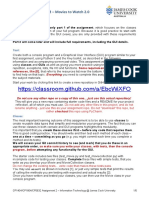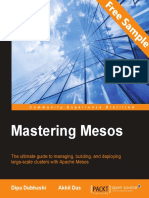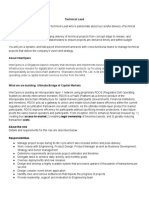Learning Yii Testing - Sample Chapter
Learning Yii Testing - Sample Chapter
Uploaded by
Packt PublishingCopyright:
Available Formats
Learning Yii Testing - Sample Chapter
Learning Yii Testing - Sample Chapter
Uploaded by
Packt PublishingCopyright
Available Formats
Share this document
Did you find this document useful?
Is this content inappropriate?
Copyright:
Available Formats
Learning Yii Testing - Sample Chapter
Learning Yii Testing - Sample Chapter
Uploaded by
Packt PublishingCopyright:
Available Formats
Fr
ee
Testing your application often and early is a key
consideration in modern web development. PHP developers
using the high-performance PHP framework Yii have
access to Codeception, a testing suite that provides
comprehensive support for unit, functional, and acceptance
tests. With Codeception, you will quickly learn how to
create fast, stable applications using a test-driven
development methodology. Learning Yii Testing embraces
a testing-first strategy to guide you in the implementation
of all possible types of tests, covering the core features
of Yii 2. Starting with the nuts and bolts of testing, you'll
walk through Yii 2's new functionality and improvements
and learn how to begin testing with it. You'll explore the
world of Codeception and gain insights into key topics
such as testing in isolation and component integration tests.
You'll also learn to analyze testing information and improve
the quality of your code. At the end of the book, you will
be able to use automation tools to reduce your
testing workload.
Who this book is written for
Understand what testing is, why you need it,
and what it encompasses
P U B L I S H I N G
Embrace the Codeception testing framework
and exploit its potential
Carefully manage the scope of tests
according to the application you're writing
Write PHPUnit tests using the full range
of its capabilities
C o m m u n i t y
E x p e r i e n c e
D i s t i l l e d
Script functional tests and test REST
interfaces
Learning Yii Testing
Write acceptance tests and make the best
use of existing frameworks such as Selenium
Discover how to abstract the knowledge
you've learned and apply it to any situation
$ 36.99 US
24.99 UK
community experience distilled
pl
Explore testing using all the features and
improvements made available with Yii 2
Matteo Pescarin
Developers who have a solid pre-existing knowledge of
Yii's core concepts will find this book an ideal introduction
to learning to write tests using Yii 2's tools. You'll learn
to create faster and more reliable applications with less
time and effort.
What you will learn from this book
Learning Yii Testing
Learning Yii Testing
Sa
m
Embrace 360-degree testing on your Yii 2 projects
using Codeception
Prices do not include
local sales tax or VAT
where applicable
Visit www.PacktPub.com for books, eBooks,
code, downloads, and PacktLib.
Matteo Pescarin
In this package, you will find:
The author biography
A preview chapter from the book, Chapter 1 'The Testing Mindset'
A synopsis of the books content
More information on Learning Yii Testing
About the Author
Matteo Pescarin started his career as a filmsetter. He cofounded a digital agency in 1998
with Emanuele Tozzato and became an expert in Flash in 2001, giving talks and writing
guides on it. He later decided to distance himself from closed source technologies and
committed himself to open standards and open source, joining the Gentoo Channel Italia,
an Italian-wide Linux User Group dedicated to the famous distro. He became passionate
about HTML and XML-related semantic technologies, combining, once again, his
passion for 2D graphics with programming.
Matteo moved to London, UK, in 2009 after getting a CS degree. While still working on
LAMP technologies, he started learning and specializing on the project management and
quality assurance side of work, where his major interests still lie.
During his spare time, Matteo pretends to be a world-renowned artist and a
formidable cook.
Learning Yii Testing
Since I've stumbled upon Yii first and Codeception later on, I couldn't believe that
someone actually thought of solving the eternal damnation of a difficult testing panorama
that most web developers, including me, have suffered with for so many years.
I've poured a good part of myself into this book, hoping that I could finally create
a book that I never managed to find when I needed to learn about testing.
I believe the hardest part has been concentrating all of the accumulated experience,
reading, conferences, and chats I've had about quality assurance, testing, and
project management.
But this wouldn't have been possible without the great effort that has been put into Yii
in its current version (version 2) and Codeception. Both these pieces of software, and the
rest that are noted throughout the book, are the result of the efforts of hundreds of
developers across the globe.
With all of this, together with the compassion and patience of Cristina, who tolerated my
restless evenings to exhaustion, I have the pleasure to release this book, hoping that you
will find an inspiration to discuss, improve, and contribute to the testing and web
development community.
What This Book Covers
Chapter 1, The Testing Mindset, starts by defining the concepts used throughout the
book, tries to explain why testing is so important, introduces the major testing techniques,
and shows you how to get into the right mindset to approach this book.
Chapter 2, Tooling up for Testing, introduces Yii 2 with an overview for you to
understand how the code is organized. We also start defining the work that will be carried
over to the remaining chapters from the testing perspective.
Chapter 3, Entering Codeception, introduces Codeception and explains what it does, how
it's structured, and how it works.
Chapter 4, Isolated Component Testing with PHPUnit, demonstrates PHPUnit. The first
unit tests are implemented in this chapter, with the help of data providers.
Chapter 5, Summoning the Test Doubles, introduces test doubles with the use of mocks
and stubs, while still sticking to PHPUnit. We also appreciate an alternative BDD-like
syntax to write our tests.
Chapter 6, Testing the API PHPBrowser to the Rescue, gives an overview of functional
tests and then shows their expansion relative to the REST interface that Yii 2 allows
you to create.
Chapter 7, Having Fun Doing Browser Testing, finally shows some live action with
acceptance tests using Selenium WebDriver.
Chapter 8, Analyzing Testing Information, covers some more advanced topics about tests
and code optimization techniques, thanks to the reports generated by Codeception and
other tools.
Chapter 9, Eliminating Stress with the Help of Automation, is a more advanced chapter
and introduces continuous integration with the aim of automating tests and displaying
their reports using Jenkins CI.
The Testing Mindset
This book has been written with the intention of teaching how to use Codeception in
conjunction with Yii 2. By using these two great frameworks, I confirmed that testing
could finally become something that anyone would appreciate doing, rather than
considering it an odd and not particularly clear appendix of development.
For this reason, this first chapter tries to address several aspects that are rarely
touched on but hopefully should give you the understanding and required push to
learn and adopt testing, and, on a larger scale, promote testing as a way to improve
development as a methodology.
In this chapter, you will see the reason for testing and why testing should be
planned into a project, and not done as an afterthought.
You will also see what will happen when you start testing: the implicit and
explicit benefits for the short and long term, such as a change of mentality toward
testing, the ability to improve component specifications, and architectural, design,
and implementation choices, as well as refactoring, redistribution, and overall
quality of code.
In order to explain why testing is so important, I'll also briefly dive into the
organizational part of the process where Test Driven Development (TDD) and
Behavior Driven Development (BDD) will be explained in relation to modern
project management techniques, such as Agile and XP in a multi-skilled, selforganized team.
You will also see how the whole team environment can be improved and
re-organized to help share knowledge and speed up workflow.
[1]
The Testing Mindset
This chapter has been divided into the following three sections:
Understanding the importance of testing
Involving project management
Obtaining the testing mindset
Understanding the importance of testing
Since I started getting into quality assurance and testing in a professional way, I've
never faced myself with the question of "what is testing?"
I have to be honest, but during my time at university, testing wasn't part of any
course. I don't really know if this has changed recently, nor if what's being taught
is of any importance or relevance to the business world.
In this book, I've tried to combine the practicality of development and testing using
a great PHP framework, Yii at its version 2, and the testing suite of Codeception.
I will present each topic with a keen eye on the actual benefit for the team, while
showing from a higher perspective the planning and the organization of the work.
Throughout the chapters in this book, I'll shift back and forth, trying to give a clear
understanding of the details you will be working on and the scope of the work,
the overall aim from a testing perspective.
But, before we venture into this journey, what effectively is testing?
Google engineering director James Whittaker's words make a very
good answer to that:
"Although it is true that quality cannot be tested in, it is equally evident that
without testing, it is impossible to develop anything of quality."
There are aspects of testing that are so completely fused with development that the
two end up being practically indistinguishable from each other, and at other times
it is so independent that developers are not even aware that this is happening.
In the whole project lifespan, you start with ideas and transform them into
features or stories, breaking them down into tasks. From there you move into the
execution of each of these tasks that will hopefully grant you, at the end of them all,
a finished product.
At any point in our development process, we have tried to put some level of quality
in it, either by "checking" the page loaded or by doing some more smart and deep,
if not automated, testing.
[2]
Chapter 1
Atlassian's QA team lead Penny Wyatt points out that teams where quality assurance
was not performed or left alone to perform small automation tasks, with unit tests
for instance, had the highest story rejection rate, which is when a story will have
to be re-opened after being completed because of wrong or missing functionality.
We are talking about a 100 percent of rejection rate.
When such a situation occurs, we are left in a state where we have to go back into
development and fix what we've done. This is not the only case: together with it, late
discovered bugs and defects, and fixing them, are possibly some of the most expensive
tasks in software development. In most cases, it has been shown that their cost is also
way higher than it would have been to prevent them in the first place. Unfortunately,
software development is rarely devoid of defects, and this should always be kept
in mind.
As developers and managers, one of the goals we should have is to reduce the
occurrence of defects to an economically acceptable level, and doing this also
reduces the resulting risk associated with it.
As a practical example, a large website might have thousands of software errors
but still be economically viable due to the fact that 99 percent of the website is
displayed correctly. For a Falcon rocket or a Formula 1 car, a defect rate that high
is not acceptable: the risk of having a single one in the wrong place might also cost
the lives of people.
The other implicit aim for defect reduction is an investment in teamwork. An error
introduced by one developer can have a ripple effect on the work of other team
members and, overall, trust in the code base and other colleagues' work. In this
chapter, and the later chapters, we are going to discuss this aspect in more detail
by introducing some concepts of project management and how it can cooperate in
ensuring that quality is ensured on many levels.
The last and possibly an equally important aspect is how testing can be used to
document the code by example. This is rarely discussed or brought to the attention
of developers, but we will see how tests can describe the functionality of our
implementations in a way more precise manner than what PHP documentation
comments can provide. I'm not saying documentation comments are useless, quite the
contrary: in modern integrated development environments (IDE) such as NetBeans
or PHPStorm, auto-completion and code hinting are a great way to improve the time
to discover the underlying framework without having the need to search through
a reference manual. Tests can and should in fact provide the much needed help a
developer might need when trying to combine and use yet unknown interfaces.
[3]
The Testing Mindset
When working with open source software that is a result of the work of a small
self-organized team, having the ability to provide documentation without an
extensive effort might be the key to rapid and continuous delivery.
But how do we ensure a delivery can be met within constraints that are imposed
on the team? In order to explain this, we will have to take a quick detour into
project management, from where some of the practices that are discussed and
used in this book have been originating.
Involving project management
If you ever have been involved in the planning phase of software development, or
if you've worked as a project manager, you should have well in mind that there are
three basic variables that you can leverage upon in order to manage projects:
Time
Quality
Cost
In most of the business scenarios described theoretically and practically,
the stakeholders decide to fix two of these variables, leaving the team to
estimate the third. In other words:
Time, Quality and Cost... pick two.
In reality, what normally happens is that time and cost end up being set outside the
project, thus leaving quality as the only variable developers can play on.
You might have already experienced that lowering quality doesn't eliminate work,
it will just postpone it. Bringing back what we said earlier regarding defect rates,
reducing quality might actually end up increasing the costs in the long run, leaving
technical debt to spiral out of control if not causing a lot of problems in the short term.
The term technical debt has been introduced as a metaphor referring to
the consequences of bad design, or architectural or development choices
in a codebase. A number of books have been written specifically to
counterbalance bad practices that are not naturally aimed at managing it.
One of the agile methodologies that are nowadays not particularly talked about,
Extreme Programming (XP), has introduced, if not rather exposed, a new variable
into the equation: scope.
[4]
Chapter 1
By making scope explicit, it does the following:
Creates a safe way to adapt
Provides a way to negotiate
Gives us a tool to keep requests and demands under control
From the XP point of view, after the breakdown phase, we will have to go through a
phase of estimating each single task, and based on the budget, you just keep adding
or removing tasks.
This discussion brings up a problem that is currently widely discussed in the
community, as estimating tasks is not as easy one might think. We'll dive into it
shortly, as I've seen too many misunderstandings of this topic.
Estimating tasks
As we've seen, estimation of the tasks has always been considered one of the
fundamental principles of how the delivery path of a project is scheduled. This is
especially valid in agile methodologies, as they use fixed time iterations and compute
the amount of features and tasks that can be fitted in the given sprint and adjusted
at each iteration using tools such as the burn down chart.
If you've worked in agile environments, this should be pretty
much easy to understand, and if you haven't, then there's plenty
of information that can be gained by reading books or articles on
SCRUM that are freely available online.
Unfortunately, with all the importance estimation has, it seems like nobody
really looked deeper into it: there are plenty of articles that warn how much
software development task estimations are always off by a factor of 2 or 3. So,
should we just swallow the fact that we won't get better at estimating or is there
something more to it?
The "estimations do not work" argument is probably not correct either, and recently
the hashtag #NoEstimates has sparked a bit of discussion online, which is probably
worth including here.
As a matter of fact, estimations do work. The only detail that is normally overlooked
is that the estimation is nearing the actual time spent on it depending on how much
knowledge the developer has and how much controllable the environment is.
[5]
The Testing Mindset
In fact, the reality is twofold: from one side, we will get better at estimating the
greater our experience is, and, on the other side, our estimation will be closer to
reality if there are less unknowns in our path.
This is well-known in project management as the Cone of Uncertainty.
What we really need to do is admit and expose all the aspects that would increase
the risk and the uncertainty of our estimations, while trying to isolate what we
know is going to take a specific amount of time.
As an example, having a fixed time investigation period to create working
prototypes of the features we are going to implement sets a precedent for future
computations, while human factors will need to be factored in.
While estimations are particularly important from the business perspective of
software development and project management, we won't be touching them again in
this book. I'd rather focus on more practical aspects of the development work flow.
Testing approaches
Extreme Programming tries to stress the investment in defect reduction.
In order to do so, it introduces two basic principles: double-checking and
Defect Cost Increase (DCI).
Double-checking is software testing. We know how a particular feature should be
working, which can be represented through a test. When implementing such a feature,
we know in a quasi-deterministic way that what we've done is actually correct.
Extreme Programming makes use of values, principles, and practices to
outline the core structure of the methodology: in short, you pick values
that describe you as a team; you adhere to certain principles that will
lead you into using specific practices.
Principles can be considered the bridge between values and practices,
justifying the use of practices on something more concrete than a mere
"but everybody's using it."
The other principle of DCI can be used to increase the cost-effectiveness of testing.
What DCI states is the following:
"The sooner you find a defect, the cheaper it is to fix."
Kent Beck
[6]
Chapter 1
To make this even more clearer with an example, if you find a defect after years
of development, it could take a lot of time to investigate both what the code was
originally meant to be doing and what was the context it was developed in the first
place. If, instead, you find the defect the minute it's being implemented, the cost
to fix it will be minimal. This, clearly, doesn't even take into consideration all the
hidden costs and risks that a severe bug can cause to critical sections of our code
base; think about security and privacy for instance.
Not only the longer we wait the more difficult the defects will be to be amended, but
also their cost will increase and have the potential to leave many residual defects.
This means that by adhering to DCI, firstly, we need to have shorter feedback cycles
so that we can continuously find as many defects as possible, and, secondly, we
will have to adopt different practices that can help us keep the cost and the quality
untouched as much as we can.
The idea of finding defects rapidly and often has been formalized as Continuous
Integration (CI) and requires bringing automated testing into play to avoid the
costs spiraling out of control. This practice has gained a lot of momentum outside
XP and it's currently used widely in many organizations regardless of the project
management methodology adopted. We will see how CI and automation can
be introduced in our work flow and development in more detail in Chapter 9,
Eliminating Stress with the Help of Automation.
These practices defy entirely the idea of working in a waterfall way, as shown in the
following figure:
The delivery path in a waterfall work flow
[7]
The Testing Mindset
In waterfall, we have a combination of factors that could impact the quality of
the work we're doing: in most of the situations where this was the norm, the
specifications are not set at the beginning nor frozen at any time. This means that
it's very likely we might not produce what the business is asking.
In other words, you would begin testing only after development, which is way too
late, as you can see from the preceding figure: you will be unable to actually catch
any of the defects in time for the release date. Unfortunately, as much as waterfall
might feel natural, its effectiveness has been disproved multiple times and I won't
invest more time on this topic.
It's worth mentioning that the definition of "waterfall", although
without using this term specifically, was formalized by Winston
W. Royce in 1970, when describing a flawed and non-working
model for software management.
Since the advent of agile methodologies, which XP is part of, there has been a great
effort to bring testing as early as possible.
Remember that testing is as important as development, so it should be quite clear
that we need to treat it as a first-class citizen.
One of the common situations you might find yourself in is that even if you start
testing right at the beginning while the code base is being developed, it could
potentially raise more issues than those that are needed or can be addressed. The
resulting situation will still generate a good amount of problems and technical debt
that won't fit within the delivery path, as you can see in the following figure:
The delivery path in an agile environment
[8]
Chapter 1
The team's goal is to eliminate all post-development testing and shift testing
resources to the beginning. If you have forms of testing such as stress or load testing
that highlight defects at the end of the development, try to bring them into the
development cycle. Try to run these tests continuously and automatically.
Transitioning into a work flow that has testing at the beginning brings to the surface
two main problems: the accumulation of technical debt and the inherent problem
that developers and testers are considered two separate entities. Don't forget that
there will be still some testing that will happen after development and will clearly
need to be performed by third parties, but, nonetheless, let's stress the fact that our
efforts are to reduce it as much as we can.
As I'll constantly remind you, testing is not someone else's problem. Instead, with
this book I'm aiming at giving the developers all the tools that can make him/her a
tester first. There are different approaches to this problem, and we'll address them
shortly at the end of this chapter, when talking about the testing mentality.
Introducing Test Driven Development
If you have ever developed with tests in mind, you might have appreciated that
getting it right from the beginning is crucial. So, what do we need to test?
Throughout the years, various methodologies have been created that provide a set of
rules for the developer that address how to include testing in the development cycle.
The first and most well-known is Test Driven Development.
The main objective of adopting TDD as a practice in your team is to achieve the
test-first mentality, and this is done using the concept of Red-Green-Refactor.
You implement the tests first, which shouldn't pass (red status), you implement
the interface being tested allowing the tests to pass (green status), and then you
refactor the interface to improve what the test has highlighted, if needed.
We've seen the benefits from the management point of view of using this approach,
but there's a more direct impact on the developer side. TDD in fact allows you to
achieve what is being taught in software development, that interfaces shouldn't be
influenced by the implementations. And, as a secondary effect, it provides, as we've
seen, a way to document the interface itself.
By implementing tests first, you focus on how the method, class, and interface should
be used by anyone inside or outside your team. This is called black box testing,
which means that our tests should be completely unaware of the implementation
details. This brings the implicit benefit of allowing the implementation to change
over time.
[9]
The Testing Mindset
If you're interested in this topic, you might find worth exploring
the Design by Contract (DbC) specification that allows you to
describe interfaces in a more formal way in specific object-oriented
programming languages. A good starting point might be found at
http://c2.com/cgi/wiki?DesignByContract.
Unfortunately, TDD tries to focus on the atomic part of the features being developed,
and it fails to give a broader vision of everything, of what has been tested and how
much, or, even better, if what has been tested is of any relevance for the business and
the product itself.
Once again, XP, in order to gain the full benefits of double-checking, introduces the
following two sets of tests:
One set written from the perspective of the programmers
Another set written from the perspective of the users
In the first case, it allows the programmers to test all the system's components
exhaustively, and in the latter case, the operation of the system as a whole.
The latter can in a way be seen as what Behavior Driven Development (BDD)
describes in a more formal way. We're going to cover BDD in more detail in
Chapter 2, Tooling up for Testing.
BDD tries to cover TDD's lack of overall scope and shifts the attention to the
behavioral aspect of the project. BDD is effectively an evolution of TDD but
requires some changes in the organization of the work and the way it's shipped,
which can be quite difficult to introduce in some environments without re-assessing
the whole workflow.
With BDD, you define what to test and how to test it on multiple levels, detailing the
scope of testing using a well-defined, business-oriented language called ubiquitous
language, borrowed by Domain-driven Design (DDD) that is shared among all
members of the team, both technical and non-technical. For the scope of this chapter,
it should suffice to say that BDD introduces the concept of stories and scenarios
giving the developer the ability to formally describe the user perspective and
functionality of your application. Tests should be written using the standard agile
framework of a user story: "As a [role] I want [feature] so that [benefit]." Acceptance
criteria should be written in terms of scenarios and implemented as classes: "Given
[initial context], when [event occurs], then [ensure some outcomes]."
[ 10 ]
Chapter 1
Planning tests
Planning is, hence, critical when stepping into testing from a software development
point of view, and in not-so-recent years, there have been several solutions to
improve testing from a planning perspective that give a more detailed and compact
way to define the so-called test plan.
In a testing-oriented environment, test plans should give you the direction and
the indications of what and how much to test at any level. Moreover, the test plan
is something that should be exposed to the various stakeholders and its visibility
shouldn't live within the walls of development. Due to this, it's our responsibility
to maintain and let this document live throughout the life of the project.
In practice, I've seen this rarely happening because test plans are never formalized
or, if they are, they are too long and hard to maintain, suffering from a very short
lifespan since their initial conception.
As an example, Attributes-Components-Capabilities (ACC) has been created by
Google in order to solve some of the main problems that test plans have always
suffered, especially their maintainability. You can find more information about
ACC and Google Test Analytics software at https://code.google.com/p/testanalytics/.
ACC test plans are short and compact, and the whole project tries to aim to test
plans that could be created in minutes and that are self-describing and valuable
to anyone close to the project.
For each component, you have a series of capabilities, which can be described with
one or more attributes; think, for instance, "secure", "fast", or "user-friendly". On top
of this, each capability and component has a relative risk level associated with it.
These two things together allow you to understand what is most important to test
and how thorough your testing should be.
Generating tests
Clearly, planning tests is just the beginning. Once you get into the implementation
side, you can pick up this book, which provides the knowledge of how to use the
tools available to create tests.
There isn't much more I can tell you about this aspect. You probably just need to
read it all, but it should be stressed that there are some basic principles you must
keep in mind when writing tests.
[ 11 ]
The Testing Mindset
Good tests exhibit the following three important characteristics:
Repeatability: Tests must be deterministic. This ensures tests aren't
dependent on external factors issues.
Simplicity: Test only one thing. The smaller the test the more
controllable it is.
Independence: Tests should execute in isolation. There should be no
dependency between tests. This also improves debugging of both the
tests and your code.
Once you've got a grip of how to approach a project, viewing it from the architectural
point of view, and once you've understood how test plans work and what you really
need to test, you can start implementing tests, discuss them, and improve
the tools and the way you're using them with the help of your colleagues.
Obtaining the testing mindset
So, up until now, we've seen how important testing is in current development
practices and we've seen all kind of aspects that revolve around development itself
from a project managing point of view, but still we don't know what's needed to
become a good tester.
Finding developers knowledgeable about testing is particularly difficult, and there
are a lot of talks online that address this problem: if that's so difficult, can't we do
better? How do we get developers to become testers in the first place, especially
when what you really want is to make developers responsible for the quality of the
code they ship since the very beginning?
I tend to agree with the general idea that a tester, or a developer knowledgeable in
testing, requires three basic things: mindset, skillsets, and knowledge.
So how do you get into acquiring or improving these three basic aspects?
Even if you can read all the books and listen to all the podcasts on testing, although
these will give you a good amount of skillsets on how to test things and how the
various testing suites and frameworks work, you won't be able to become a tester
simply with that.
Of course, practice can help you a lot, but, all in all, the quality mindset and the
knowledge of what to test are probably the hardest to acquire.
[ 12 ]
Chapter 1
The knowledge part comes from a higher view of the product, both from the
technical side and the business end. Introducing project breakdowns and pitches
for the features that are going to be introduced in our software can be a starting
point in this process.
The quality mindset can be the trickiest of them all, as it ends up being baked into
all sort of aspects of software development from the technical point of view and
requires a proactive participation from all the parties involved, first of all starting
with the developer.
As previously said, there isn't a fixed definition of what you can achieve in terms of
quality. There's no upper limit on how much quality you can put into your project.
Hence, there's no limit on how much testing you can do in any project.
From what I've witnessed, there are two requirements that can speed up the process
of becoming a good tester on top of being a good developer: one of these comes from
the environment, the other comes from us.
The environment bit in my opinion is the one that could potentially cut the deal to
acquire the right testing mindset that we are talking about, and getting there should
probably be the priority of any company that decides that quality has value, and a
measurable one.
Surely, having someone that can do mentoring on testing has always worked the
best: learning by imitation and debating are probably the best team-oriented tools
around. Even if you don't have a tester in your team, you might have noticed that in
development, practices such as paired programming or code reviews can go a long
way to keep the team up to speed with the practices and knowledge required.
Let's have a closer look at what this would mean in practice, keeping in mind that
there is no silver bullet in terms of applied practices and methodologies, and it's
your task to experiment and adapt based on what you have at hand.
Starting with no testing culture a practical
approach
In this series of practical examples on how to introduce testing in a team or
project, we are going to assume a couple of requirements that are indispensable
in getting you somewhere.
In this specific instance, we're going to assume you're working in a team. The ideal
situation is to have a team of at least three people.
[ 13 ]
The Testing Mindset
If you're working with less than three people, or you're a lone
developer, most of the techniques and practices tend to have a
cost which might be higher than the perceived benefit.
A test plan and a sound organization of your workflow (trying
to keep things simple) will not only provide a solid ground
for working in a larger team if needed, but also grant you the
instrument to deliver quality at speed.
First of all, you need support from the business and your direct managers; speaking
of direct and indirect experience, without that you won't get anywhere. The business
side of the company needs to understand what testing is, in the way that is has been
described at the beginning of this chapter, the value of testing, and all the good
things that this can bring. There is plenty of documentation online for you to build
a business case.
Secondly, you need to have some skillsets in testing. This book should cover that
parthopefully quite welland there are plenty of others that can teach you more
theoretical aspects of testing for programmers and engineers, without considering
the amount of online resources available on the topic.
A few good articles you can find online are as follows:
Unit testing: Why bother? available at http://
soundsoftware.ac.uk/unit-testing-why-bother/
Testing at Airbnb available at http://nerds.airbnb.com/
testing-at-airbnb/
Once you've got this, you can start moving into action.
One of the situations most might find themselves in is that there is no testing culture
whatsoever. Here you have two choices: either take the bottom-up approach, and get
yourself familiar with TDD as a starter, or take the top-down one, where you'll take
the higher perspective.
Either way you need to start having a compact test plan to adhere to. Taking as an
example the approach of ACC, you start by breaking down the application/project/
library into modules (components), each of them will be composed of features
(capabilities). Each feature will be denoted with a particular attribute. From there
you should have a compact enough representation of what you're trying to achieve.
On top of this, you can start assigning a relative risk level, which you will use to
give priority for your testing approach defining what and how much to test.
[ 14 ]
Chapter 1
The resulting test plan should be signed off by all the stakeholders and updated as
frequently as possible, defining the aim of the project itself. The more this document
is official the better it is, as it will be considered the business card of the project.
As highlighted by many, the immediate aim is to start planting the culture of
testing in developers. Define the scope of your work, both in terms of testing and
development, proceed with caution and evaluate both risks and costs, and leverage
on those to take a decision on how to approach tests.
Thankfully, if you're finding yourself working with Yii and Codeception, you
should be spared a bit of headaches putting together different frameworks and
wasting a bit of time experimenting a working solution.
Team-wise, when the experience in testing is not widespread nor solid, additional
practices can be introduced that can help avoid bottlenecks or have all the knowledge
trapped in a single person, such as paired programming and code reviews.
Some companies, like Atlassian, introduced test engineers that could help the
teams, both from a mentoring perspective and a mere quality assurance side. Their
interventions in the development cycle ended up being confined to a more restricted
participation, at the very beginning and before completing the task. Their role is,
nonetheless, fundamental, as they became the guardians of the testing infrastructure,
the tools, and the practices to be adopted, while the developer grew to become a fully
fledged tester who can cover almost any aspect of testing without much support.
Summary
In this chapter, we've covered many aspects that are directly connected with testing,
but are not strictly necessary to start testing, although they are fundamental if
you want to understand why you've taken up this book and if it's necessary to go
through the rest of it.
You've seen why it's important to test, some project management methodologies,
how to estimate tasks and what it entails, and you've seen different testing
approaches such as TDD and BDD, which will be the basis for many of the remaining
chapters. At the end, I've tried to give an idea of what it takes to gain the testing
mindset required to become a master in this art.
In Chapter 2, Tooling up for Testing, we will start gearing up with the tools we are
going to use throughout the rest of this book, understanding the basics of Yii 2
and applying what we've learned in this chapter by outlining our test plan.
[ 15 ]
Get more information Learning Yii Testing
Where to buy this book
You can buy Learning Yii Testing from the Packt Publishing website.
Alternatively, you can buy the book from Amazon, BN.com, Computer Manuals and most internet
book retailers.
Click here for ordering and shipping details.
www.PacktPub.com
Stay Connected:
You might also like
- Software Dev Processes Project 1Document2 pagesSoftware Dev Processes Project 1ereter50% (8)
- Hypermodern Python ToolingDocument501 pagesHypermodern Python ToolingADUGNA DEGEFENo ratings yet
- Outside in React Development SampleDocument63 pagesOutside in React Development SampleMuhammad ShariqNo ratings yet
- Clean CraftsmanshipDocument471 pagesClean CraftsmanshipCleverton Heusner100% (2)
- The Leprechauns of Software Engineering - Laurent Bossavit (2013)Document183 pagesThe Leprechauns of Software Engineering - Laurent Bossavit (2013)linglingxu31No ratings yet
- CSIT1114 - Lab2 - 1230 - Ms. Sara Majed - 8192959Document7 pagesCSIT1114 - Lab2 - 1230 - Ms. Sara Majed - 8192959adam hopeNo ratings yet
- Agile Complete MergedDocument82 pagesAgile Complete MergedKiran Dilli KumarNo ratings yet
- Mastering Selenium WebDriver - Sample ChapterDocument39 pagesMastering Selenium WebDriver - Sample ChapterPackt PublishingNo ratings yet
- Test, Jason - QUANTUM COMPUTING WITH PYTHON_ the New Comprehensive Guide to Master Applied Artificial Intelligence in Physics. Learn Machine Learning and Computer Programming With a Complete Crash Course (2021)Document457 pagesTest, Jason - QUANTUM COMPUTING WITH PYTHON_ the New Comprehensive Guide to Master Applied Artificial Intelligence in Physics. Learn Machine Learning and Computer Programming With a Complete Crash Course (2021)Sayantan RoyNo ratings yet
- JIRA 7 Administration Cookbook Second Edition - Sample ChapterDocument35 pagesJIRA 7 Administration Cookbook Second Edition - Sample ChapterPackt PublishingNo ratings yet
- BugBytes (April, 19) - The Monthly QA Newsletter by 2PiR TechnologiesDocument11 pagesBugBytes (April, 19) - The Monthly QA Newsletter by 2PiR Technologies2PiR TechnologiesNo ratings yet
- Test Driven Machine Learning - Sample ChapterDocument25 pagesTest Driven Machine Learning - Sample ChapterPackt Publishing100% (1)
- Enthuzia SticDocument9 pagesEnthuzia Sticdaddarioalexander01No ratings yet
- Test-Driven Development with C++: A simple guide to writing bug-free Agile codeFrom EverandTest-Driven Development with C++: A simple guide to writing bug-free Agile codeNo ratings yet
- Test-Driven Java Development - Sample ChapterDocument35 pagesTest-Driven Java Development - Sample ChapterPackt PublishingNo ratings yet
- Crafting Test-Driven Software with Python: Write test suites that scale with your applications' needs and complexity using Python and PyTestFrom EverandCrafting Test-Driven Software with Python: Write test suites that scale with your applications' needs and complexity using Python and PyTestNo ratings yet
- Simplify Testing with React Testing Library: Create maintainable tests using RTL that do not break with changesFrom EverandSimplify Testing with React Testing Library: Create maintainable tests using RTL that do not break with changesNo ratings yet
- Weekly_Assignment_Example_Helen_Caspersson_Assignment_2Document13 pagesWeekly_Assignment_Example_Helen_Caspersson_Assignment_2sam pereraNo ratings yet
- What is Software Testing?: ISTQB Foundation Companion and Study GuideFrom EverandWhat is Software Testing?: ISTQB Foundation Companion and Study GuideRating: 5 out of 5 stars5/5 (8)
- Mastering Behavior-Driven Development Using Cucumber: Practice and Implement Page Object Design Pattern, Test Suites in Cucumber, POM TestNG Integration, Cucumber Reports, and work with Selenium GridFrom EverandMastering Behavior-Driven Development Using Cucumber: Practice and Implement Page Object Design Pattern, Test Suites in Cucumber, POM TestNG Integration, Cucumber Reports, and work with Selenium GridNo ratings yet
- How To Design Smart Business ExperimentDocument1 pageHow To Design Smart Business Experimentdoanchi0612No ratings yet
- Mockito CookbookDocument23 pagesMockito CookbookPackt PublishingNo ratings yet
- Test-Driven Development in Go: A practical guide to writing idiomatic and efficient Go tests through real-world examplesFrom EverandTest-Driven Development in Go: A practical guide to writing idiomatic and efficient Go tests through real-world examplesNo ratings yet
- Test-Driven Development With Django - Sample ChapterDocument16 pagesTest-Driven Development With Django - Sample ChapterPackt PublishingNo ratings yet
- Test-Driven Development with React: Apply Test-Driven Development in Your ApplicationsFrom EverandTest-Driven Development with React: Apply Test-Driven Development in Your ApplicationsNo ratings yet
- Hello World: Student to Software Professional - a Transformation GuideFrom EverandHello World: Student to Software Professional - a Transformation GuideNo ratings yet
- Test-Driven iOS Development with Swift 4 - Third Edition: Write Swift code that is maintainable, flexible, and easily extensibleFrom EverandTest-Driven iOS Development with Swift 4 - Third Edition: Write Swift code that is maintainable, flexible, and easily extensibleNo ratings yet
- Chapter 1Document10 pagesChapter 1Sofia LivelyNo ratings yet
- Valuedrive Technologies PVT 1 PDFDocument22 pagesValuedrive Technologies PVT 1 PDFabhijeetpandey0011No ratings yet
- Visual Studio 2010 Best Practices: Learn and implement recommended practices for the complete software development lifecycle with Visual Studio 2010 with this book and ebook.From EverandVisual Studio 2010 Best Practices: Learn and implement recommended practices for the complete software development lifecycle with Visual Studio 2010 with this book and ebook.No ratings yet
- Extreme ProgrammingDocument15 pagesExtreme ProgrammingSaumya SwapnesawrNo ratings yet
- ESLT Web3 CurriculumDocument8 pagesESLT Web3 Curriculumwipro.chinemeNo ratings yet
- How To Do Well in QCDocument2 pagesHow To Do Well in QC5mnrmc595dNo ratings yet
- Exploratory TestingDocument97 pagesExploratory TestingZammy Abraham Cristo TovarNo ratings yet
- Python For Beginners A Crash Course Guide For Machine Learning and Web Programming (2020) - 40639Document96 pagesPython For Beginners A Crash Course Guide For Machine Learning and Web Programming (2020) - 40639lymorillom100% (1)
- MicroPython Projects: A do-it-yourself guide for embedded developers to build a range of applications using PythonFrom EverandMicroPython Projects: A do-it-yourself guide for embedded developers to build a range of applications using PythonNo ratings yet
- Introduction To Agile Testing PDFDocument12 pagesIntroduction To Agile Testing PDFTomislav PreissNo ratings yet
- DevOps: Continuous Delivery, Integration, and Deployment with DevOps: Dive into the core DevOps strategiesFrom EverandDevOps: Continuous Delivery, Integration, and Deployment with DevOps: Dive into the core DevOps strategiesNo ratings yet
- CP1404 - Assignment 2 - Movies To Watch 2.0 (Part 1 ONLY) : TaskDocument5 pagesCP1404 - Assignment 2 - Movies To Watch 2.0 (Part 1 ONLY) : TaskJACK LuckyNo ratings yet
- Extending Jenkins: Get a complete walkthrough of the many interfaces available in Jenkins with the help of real-world examples to take you to the next level with JenkinsFrom EverandExtending Jenkins: Get a complete walkthrough of the many interfaces available in Jenkins with the help of real-world examples to take you to the next level with JenkinsNo ratings yet
- Python Apps on Visual Studio Code: Develop apps and utilize the true potential of Visual Studio Code (English Edition)From EverandPython Apps on Visual Studio Code: Develop apps and utilize the true potential of Visual Studio Code (English Edition)No ratings yet
- Jenkins Continuous Integration Cookbook Second Edition Sample ChapterDocument55 pagesJenkins Continuous Integration Cookbook Second Edition Sample ChapterPackt PublishingNo ratings yet
- Best Practices in Agile TestingDocument12 pagesBest Practices in Agile TestingRanjith KumarNo ratings yet
- Overview and InstallationDocument12 pagesOverview and InstallationGkfb ACNo ratings yet
- Sample ThesisDocument6 pagesSample ThesisHelpMeWithMyPaperRochester100% (2)
- Practical Test-Driven Development using C# 7: Unleash the power of TDD by implementing real world examples under .NET environment and JavaScriptFrom EverandPractical Test-Driven Development using C# 7: Unleash the power of TDD by implementing real world examples under .NET environment and JavaScriptNo ratings yet
- Hartjes C. The Grumpy Programmer's PHPUnit Cookbook 2014Document78 pagesHartjes C. The Grumpy Programmer's PHPUnit Cookbook 2014Lorenzo-Aubrey FabroNo ratings yet
- The DevOps handbook how to create world class agility reliability and security in technology organizations First Edition Allspaw all chapter instant downloadDocument52 pagesThe DevOps handbook how to create world class agility reliability and security in technology organizations First Edition Allspaw all chapter instant downloadnielrijil100% (3)
- Mastering React Test-Driven Development.: Build simple and maintainable web apps with React, Redux, and GraphQLFrom EverandMastering React Test-Driven Development.: Build simple and maintainable web apps with React, Redux, and GraphQLNo ratings yet
- Grumpy Testing SampleDocument14 pagesGrumpy Testing Samplenermin_226No ratings yet
- Worksheet 2.11 Unit TestingDocument8 pagesWorksheet 2.11 Unit TestingEdwar ReyNo ratings yet
- IBM-CBSE - AI - Project - Guide-For Class 12Document29 pagesIBM-CBSE - AI - Project - Guide-For Class 12Mani Maran100% (1)
- Global App Testing - The Ultimate QA Testing HandbookDocument71 pagesGlobal App Testing - The Ultimate QA Testing Handbooknick_knack007No ratings yet
- Immediate download Learning Test-Driven Development: A Polyglot Guide to Writing Uncluttered Code Saleem Siddiqui ebooks 2024Document40 pagesImmediate download Learning Test-Driven Development: A Polyglot Guide to Writing Uncluttered Code Saleem Siddiqui ebooks 2024celiafewoxai100% (2)
- It Coursework EvaluationDocument5 pagesIt Coursework Evaluationafjwfugcueaonf100% (2)
- Hiring Testers: Best ofDocument60 pagesHiring Testers: Best ofConstantinAlinNo ratings yet
- Decoding Google Summer OF Code: Toptalent - inDocument10 pagesDecoding Google Summer OF Code: Toptalent - inGaurav MahalNo ratings yet
- Capstone Exercise WorkbookDocument11 pagesCapstone Exercise WorkbookÁlvaro Augusto Cote FlórezNo ratings yet
- Practical Digital Forensics - Sample ChapterDocument31 pagesPractical Digital Forensics - Sample ChapterPackt Publishing100% (2)
- Moodle 3.x Teaching Techniques - Third Edition - Sample ChapterDocument23 pagesMoodle 3.x Teaching Techniques - Third Edition - Sample ChapterPackt PublishingNo ratings yet
- Modular Programming With Python - Sample ChapterDocument28 pagesModular Programming With Python - Sample ChapterPackt PublishingNo ratings yet
- RESTful Web API Design With Node - Js - Second Edition - Sample ChapterDocument17 pagesRESTful Web API Design With Node - Js - Second Edition - Sample ChapterPackt Publishing0% (1)
- Mastering Mesos - Sample ChapterDocument36 pagesMastering Mesos - Sample ChapterPackt PublishingNo ratings yet
- Unity 5.x Game Development Blueprints - Sample ChapterDocument57 pagesUnity 5.x Game Development Blueprints - Sample ChapterPackt PublishingNo ratings yet
- Python Geospatial Development - Third Edition - Sample ChapterDocument32 pagesPython Geospatial Development - Third Edition - Sample ChapterPackt PublishingNo ratings yet
- Mastering Drupal 8 Views - Sample ChapterDocument23 pagesMastering Drupal 8 Views - Sample ChapterPackt Publishing0% (1)
- Cardboard VR Projects For Android - Sample ChapterDocument57 pagesCardboard VR Projects For Android - Sample ChapterPackt PublishingNo ratings yet
- Android UI Design - Sample ChapterDocument47 pagesAndroid UI Design - Sample ChapterPackt PublishingNo ratings yet
- Puppet For Containerization - Sample ChapterDocument23 pagesPuppet For Containerization - Sample ChapterPackt PublishingNo ratings yet
- Flux Architecture - Sample ChapterDocument25 pagesFlux Architecture - Sample ChapterPackt PublishingNo ratings yet
- Expert Python Programming - Second Edition - Sample ChapterDocument40 pagesExpert Python Programming - Second Edition - Sample ChapterPackt Publishing40% (5)
- Angular 2 Essentials - Sample ChapterDocument39 pagesAngular 2 Essentials - Sample ChapterPackt Publishing0% (1)
- Internet of Things With Python - Sample ChapterDocument34 pagesInternet of Things With Python - Sample ChapterPackt Publishing100% (1)
- Mastering Hibernate - Sample ChapterDocument27 pagesMastering Hibernate - Sample ChapterPackt PublishingNo ratings yet
- Practical Mobile Forensics - Second Edition - Sample ChapterDocument38 pagesPractical Mobile Forensics - Second Edition - Sample ChapterPackt PublishingNo ratings yet
- QGIS 2 Cookbook - Sample ChapterDocument44 pagesQGIS 2 Cookbook - Sample ChapterPackt Publishing100% (1)
- Apache Hive Cookbook - Sample ChapterDocument27 pagesApache Hive Cookbook - Sample ChapterPackt Publishing100% (1)
- Learning Probabilistic Graphical Models in R - Sample ChapterDocument37 pagesLearning Probabilistic Graphical Models in R - Sample ChapterPackt PublishingNo ratings yet
- Troubleshooting NetScaler - Sample ChapterDocument25 pagesTroubleshooting NetScaler - Sample ChapterPackt PublishingNo ratings yet
- Sitecore Cookbook For Developers - Sample ChapterDocument34 pagesSitecore Cookbook For Developers - Sample ChapterPackt PublishingNo ratings yet
- Practical Linux Security Cookbook - Sample ChapterDocument25 pagesPractical Linux Security Cookbook - Sample ChapterPackt Publishing100% (1)
- Odoo Development Cookbook - Sample ChapterDocument35 pagesOdoo Development Cookbook - Sample ChapterPackt Publishing100% (1)
- RStudio For R Statistical Computing Cookbook - Sample ChapterDocument38 pagesRStudio For R Statistical Computing Cookbook - Sample ChapterPackt Publishing100% (1)
- Machine Learning in Java - Sample ChapterDocument26 pagesMachine Learning in Java - Sample ChapterPackt Publishing100% (1)
- Canvas Cookbook - Sample ChapterDocument34 pagesCanvas Cookbook - Sample ChapterPackt PublishingNo ratings yet
- 3D Printing Designs: Design An SD Card Holder - Sample ChapterDocument16 pages3D Printing Designs: Design An SD Card Holder - Sample ChapterPackt Publishing100% (1)
- Sass and Compass Designer's Cookbook - Sample ChapterDocument41 pagesSass and Compass Designer's Cookbook - Sample ChapterPackt PublishingNo ratings yet
- PDF Head First Software Development 1st Edition Dan Pilone downloadDocument50 pagesPDF Head First Software Development 1st Edition Dan Pilone downloaduzzielwingon100% (3)
- 16.DebuggingDocument94 pages16.DebuggingKamalesh PantraNo ratings yet
- CoreDocument47 pagesCoreAC ManeNo ratings yet
- 50+ QA Interview Questions and Answers 2023Document18 pages50+ QA Interview Questions and Answers 2023hieuphan160999No ratings yet
- ITS66404 Principles of Software Engineering Assignment 2Document41 pagesITS66404 Principles of Software Engineering Assignment 2House Of MoviesNo ratings yet
- PMIT 6111 Lecture 1 Introduction to SDLCDocument37 pagesPMIT 6111 Lecture 1 Introduction to SDLCsubscribtionbs8755No ratings yet
- SESlides 5Document21 pagesSESlides 5tayyabson06No ratings yet
- STM Viva QueDocument54 pagesSTM Viva Quearellasaikiran100% (2)
- Software Testing Techniques: A Literature Review: November 2016Document7 pagesSoftware Testing Techniques: A Literature Review: November 2016Varnit KumarNo ratings yet
- _.NET Backend Developer Roadmap 2025 by Ajay PatelDocument32 pages_.NET Backend Developer Roadmap 2025 by Ajay Patelwicin66400No ratings yet
- Mockito Programming CookbookDocument74 pagesMockito Programming CookbookAndrei Lucian Mircioagă100% (1)
- ISTQB Foundation BookDocument111 pagesISTQB Foundation Bookjainrobin100% (5)
- Single Page Apps in Depth: 1. Modern Web Applications: An OverviewDocument65 pagesSingle Page Apps in Depth: 1. Modern Web Applications: An OverviewAbhishek KumarNo ratings yet
- Agile Testing 1210187639850462 9Document91 pagesAgile Testing 1210187639850462 9Sudip DebNo ratings yet
- SEPM Unit1Document18 pagesSEPM Unit1Anuj TilekarNo ratings yet
- Course - Automated Test Framework - ServiceNow DevelopersDocument141 pagesCourse - Automated Test Framework - ServiceNow Developersmartin100% (1)
- Download Complete Patterns in the Machine A Software Engineering Guide to Embedded Development 1st Edition John T Taylor Wayne T Taylor PDF for All ChaptersDocument65 pagesDownload Complete Patterns in the Machine A Software Engineering Guide to Embedded Development 1st Edition John T Taylor Wayne T Taylor PDF for All Chapterskhathboornri100% (3)
- Test Automationusing Seleniumwith CSharp PreviewDocument20 pagesTest Automationusing Seleniumwith CSharp PreviewSachinNo ratings yet
- Andrew Wallace - Sr. Android Developer Resume in Atlanta, GA - September 2021Document1 pageAndrew Wallace - Sr. Android Developer Resume in Atlanta, GA - September 2021JLTNo ratings yet
- MVC NotesDocument101 pagesMVC NotesPranjal Bajpai100% (1)
- ISTQB CTFL v4.0 Sample-Exam-B-Answers v1.0Document37 pagesISTQB CTFL v4.0 Sample-Exam-B-Answers v1.0AmJNo ratings yet
- Agile Testing NotesDocument4 pagesAgile Testing NotesPackiyaraj BMSNo ratings yet
- 3311 W04 Bank Case Study PDFDocument52 pages3311 W04 Bank Case Study PDFWaqas AhmedNo ratings yet
- INF3705 Exam SummaryDocument43 pagesINF3705 Exam SummaryBertus0% (1)
- PDF Engineering Software as a Service An Agile Approach Using Cloud Computing 1st Edition Armando Fox & David Patterson downloadDocument68 pagesPDF Engineering Software as a Service An Agile Approach Using Cloud Computing 1st Edition Armando Fox & David Patterson downloaddokosiwahdan100% (3)
- InterOpera - Tech Lead DescriptionDocument2 pagesInterOpera - Tech Lead DescriptionmanishkprNo ratings yet
- CS-321 Software EngineeringDocument4 pagesCS-321 Software Engineeringabdulrafy0077No ratings yet























































































































